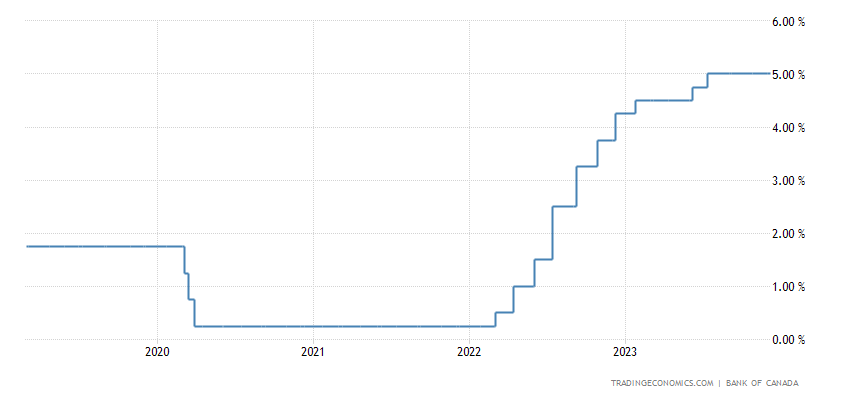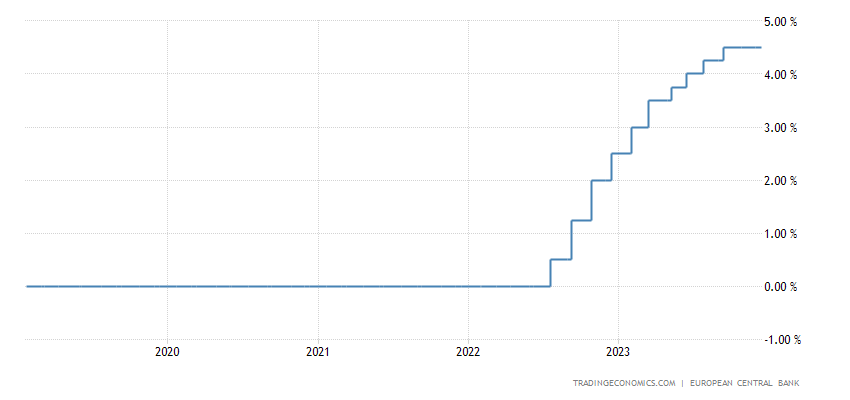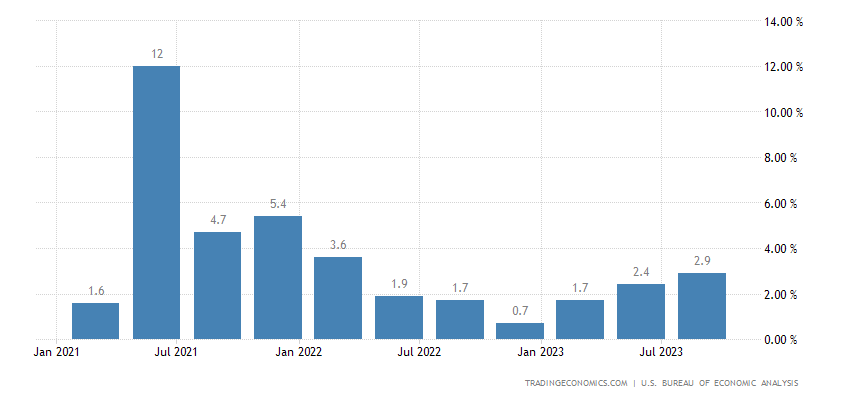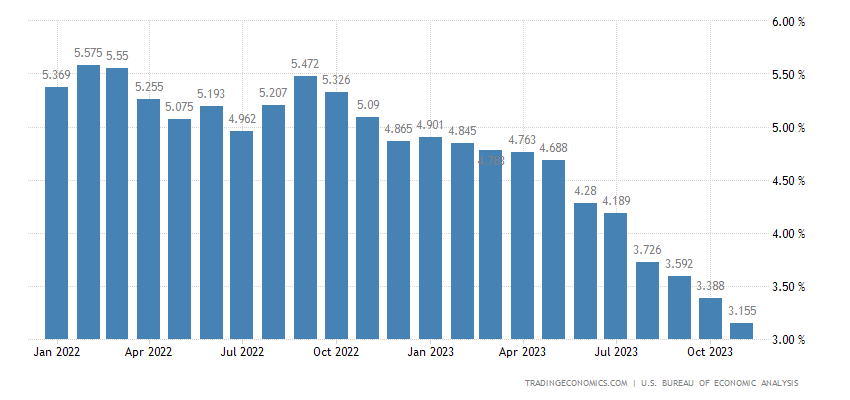As earnings season continues, the financial results of technology companies such as Microsoft, Tesla and Intel would be particularly important for investors in the coming week. Depending on the results, these could be both a driving force and a cold shower. For the Canadian dollar and the euro, interest rate decisions, along with statements from the Governors of the Bank of Canada and the European Central Bank following the announced decisions, could be key. In addition, let's look out this week for the first US GDP forecasts for Q4 2023. These may confirm or deny the thesis of the end of the US economic slowdown.
Table of contents:
- Interest rate decision in Canada
- Eurozone interest rate decision
- US preliminary estimates of gross domestic product (GDP) annualised (Q4)
- US core price index (PCE) annualised (December)
- Stocks to watch
Wednesday, 24.01, 15:00 GMT, Interest rate decision in Canada
In December 2023. The Bank of Canada's Economic Council decided to maintain the interest rate at 5%, recognising that previous monetary policy actions have had the intended effect in cooling the economy and easing price pressures. Council members recognise the risks to the inflation outlook, even though policy appears sufficiently restrictive to bring price dynamics to the desired target. Policy makers have therefore maintained their readiness to possibly raise the interest rate. To monitor inflationary pressures, they will focus on the balance of supply and demand, wage growth, prices and inflation expectations. Inflation in Canada currently stands at 3.4 per cent, close to the inflation target, set at between 1 and 3 per cent.
The current analyst forecast is for no change in interest rates by the Bank of Canada at the upcoming meeting.

Source: Tradingeconomics.com
A higher-than-expected interest rate could be bullish for CAD, while a lower-than-expected interest rate could be bearishly on CAD.
Impact: CAD
Thursday, 25.01, 13:15 GMT, Eurozone interest rate decision
At the December 2023 meeting of the Economic Council of the European Central Bank (ECB), it was decided to keep the ECB's three key interest rates unchanged. This is because inflation in the euro area is expected to gradually decline and gradually move towards the Economic Council's 2% target. At present, inflation is 2.9% and the ECB forecasts that average figures for general inflation will reach 2.7% in 2024, 2.1% in 2025 and 1.9% in 2026, a reduction from last September's forecasts.
Earlier interest rate rises continue to impact the economy, reducing demand. Low economic growth is expected to continue for the foreseeable future. However, forecasts assume an improvement due to rising real incomes and an increase in foreign demand.
The latest announcement shows that the Council will continue to normalise the balance sheet, planning to reduce the Pandemic Purchase Programme Portfolio (PEPP) by €7.5 billion per month from the second half of 2024.
The current analyst forecast is for the interest rate to remain at 4.5%.

Source: Tradingeconomics.com
A higher-than-expected interest rate could be bullish for the EUR, while a lower-than-expected interest rate could act bearishly on the EUR.
Impact: EUR
Thursday, 25.01, 13:30 GMT, US preliminary estimates of gross domestic product (GDP) annualised (Q4)
Gross domestic product (GDP) indicates the total value of goods and services produced in a country for a certain period. GDP is an important indicator of the health of an economy because it gives an overall picture of how well or poorly it is doing. If the GDP growth is higher than expected, the economy is in good shape and growing faster than expected. On the other hand, if the GDP growth is lower than expected, the economy performs weaker than anticipated. Furthermore, if the GDP growth is negative for two consecutive quarters, it may be considered a technical recession due to contracting economic output.
The US economy grew at a rate of 4.9% (k/k) in Q3 2023, which turned out to be, slightly below expectations of 5.3%. This rate of growth implies annual GDP growth of 2.9%, and this represents the fastest growth since Q1 2022. The world's largest economy appears to be returning to its long-term growth rate.
The current forecast is for a slowdown in the quarterly growth rate to 1.8%.

Source: Tradingeconomics.com
A higher-than-expected reading could have a bullish impact on the USD, while a lower-than-expected reading could be bearish for the USD.
Impact: USD
Wednesday, 17.01, 10:00 GMT, US core price index (PCE) annualised (December)
PCE inflation, or the Personal Consumption Expenditures Index, is a price index that monitors changes in the prices of goods and services purchased by households. It is a key measure of inflation, used by the Federal Reserve in the United States to assess the cost of living. The PCE Index is widely used in economic analysis and monetary policy decision-making.
The core PCE index, which excludes food and energy, rose to 3.2% in November 2023, now standing at its lowest level in 20 months. This result came in slightly below expectations. Current forecasts point to core PCE inflation remaining at 3.2%.

Source: Tradingeconomics.com
A higher-than-expected reading could have a bullish impact on the USD, while a lower-than-expected reading could be bearish for the USD.
Impact: USD
Stocks to watch
Microsoft (MSFT) announces financial results for the quarter ending December 2023. Forecast EPS: 2.29. Positive earnings surprise in 9 of last 10 reports. Deadline: Tuesday, 23 January.
Netflix (NFLX) announces financial results for the quarter ending December 2023. Forecast EPS: 2.2. Positive earnings surprise in 8 of last 10 reports. Deadline: Tuesday, 23 January.
Tesla (TSLA) announces financial results for the quarter ending December 2023. Forecast EPS: 0.7236. Positive earnings surprise in 8 of last 10 reports. Deadline: Wednesday, 24 January.
Intel (INTC) announces financial results for the quarter ending December 2023. Forecast EPS: 0.4463 Positive earnings surprise in 8 of last 10 reports. Deadline: Thursday, 25 January.
Grzegorz Dróżdż, CAI MPW, Market Analyst of Conotoxia Ltd. (Conotoxia investment service)
Materials, analysis and opinions contained, referenced or provided herein are intended solely for informational and educational purposes. Personal opinion of the author does not represent and should not be constructed as a statement or an investment advice made by Conotoxia Ltd. All indiscriminate reliance on illustrative or informational materials may lead to losses. Past performance is not a reliable indicator of future results.
CFDs are complex instruments and come with a high risk of losing money rapidly due to leverage. 71.98% of retail investor accounts lose money when trading CFDs with this provider. You should consider whether you understand how CFDs work and whether you can afford to take the high risk of losing your money.


